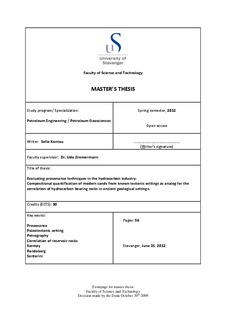| dc.contributor.author | Kontou, Sofia | |
| dc.date.accessioned | 2012-11-13T10:18:46Z | |
| dc.date.available | 2012-11-13T10:18:46Z | |
| dc.date.issued | 2012 | |
| dc.identifier.uri | http://hdl.handle.net/11250/183470 | |
| dc.description | Master's thesis in Petroleum Geosciences engineering | no_NO |
| dc.description.abstract | Major and trace element analyses show different compositions between the sediments of the Karmøy southeast shoreline and the sediments of northern Randaberg. Also supported form petrographic analyses, the Karmøy samples indicate a mafic source with andesitic to sub-alkaline basalt composition, low to moderate content of SiO2, enrichment in Cr, V, and Co and very low Y/Ni ratios. On the contrary, both petrographic and geochemical analyses of the Randaberg samples show a more felsic composition, similar to unrecycled UCC, with a rhyodacitic to dacitic composition and low concentrations of Cr, V, and Co. The sands from Santorini do not derive from the calcite-rich carboniferous basement that is exposed on the island; instead their source is the recent volcanic rocks with rhyodacitic/dacitic to andesitic composition typical of active subduction zones. The sediments from all three areas are only moderately to partly unweathered and show no significant recycling. Lithic-fragment and mineral compositions are closely related to the adjacent source rocks. The sediments from Santorini mirror the composition of the volcanic source rocks and the paleotectonic environment of continental arc is easily deduced from the geochemical results. In contrast, the sediments from southwest Norway do not reflect the proposed paleotectonic environment of passive margin. Both petrographic and geochemical analyses indicate an oceanic arc environment for the Karmøy sediments and an active continental margin for the Randaberg sediments. Therefore, provenance determination is not possible in southwest Norway and further analyses are needed. Correlation between the sediments of Karmøy and Randaberg is very difficult and should be done with great caution and further sampling. However, the provenance techniques can be used with accuracy in Santorini whilst the validity of the results could be explained by the much younger age of the source rocks. | no_NO |
| dc.language.iso | eng | no_NO |
| dc.publisher | University of Stavanger, Norway | no_NO |
| dc.relation.ispartofseries | Masteroppgave/UIS-TN-IPT/2012; | |
| dc.subject | provenance | no_NO |
| dc.subject | paleotectonic setting | no_NO |
| dc.subject | petrography | no_NO |
| dc.subject | correlation of reservoir rocks | no_NO |
| dc.subject | Karmøy | no_NO |
| dc.subject | Santorini | no_NO |
| dc.subject | Randaberg | no_NO |
| dc.subject | petroleumsgeologi | no_NO |
| dc.title | Evaluating provenance techniques in the hydrocarbon industry: Compositional quantification of modern sands from known tectonic settings as analog for the correlation of hydrocarbon bearing rocks in ancient geological settings. | no_NO |
| dc.type | Master thesis | no_NO |
| dc.subject.nsi | VDP::Technology: 500::Rock and petroleum disciplines: 510::Petroleum engineering: 512 | no_NO |
| dc.source.pagenumber | 56 | no_NO |
